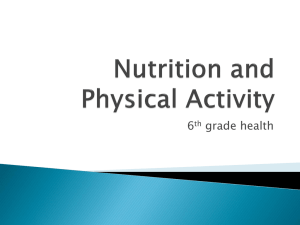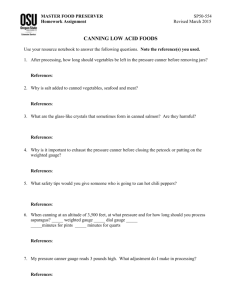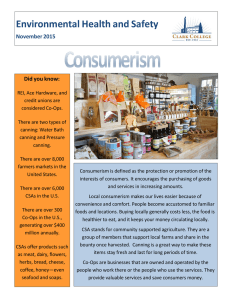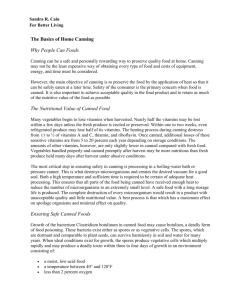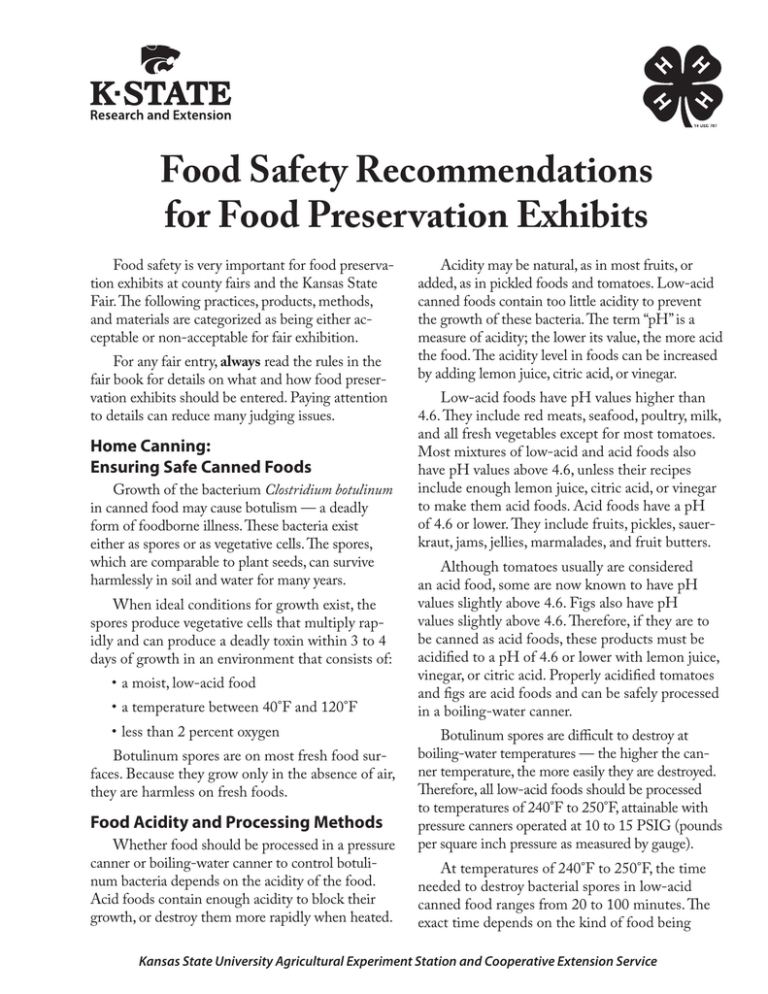
Food Safety Recommendations
for Food Preservation Exhibits
Food safety is very important for food preservation exhibits at county fairs and the Kansas State
Fair. The following practices, products, methods,
and materials are categorized as being either acceptable or non-acceptable for fair exhibition.
For any fair entry, always read the rules in the
fair book for details on what and how food preservation exhibits should be entered. Paying attention
to details can reduce many judging issues.
Home Canning:
Ensuring Safe Canned Foods
Growth of the bacterium Clostridium botulinum
in canned food may cause botulism — a deadly
form of foodborne illness. These bacteria exist
either as spores or as vegetative cells. The spores,
which are comparable to plant seeds, can survive
harmlessly in soil and water for many years.
When ideal conditions for growth exist, the
spores produce vegetative cells that multiply rapidly and can produce a deadly toxin within 3 to 4
days of growth in an environment that consists of:
•a moist, low-acid food
•a temperature between 40°F and 120°F
•less than 2 percent oxygen
Botulinum spores are on most fresh food surfaces. Because they grow only in the absence of air,
they are harmless on fresh foods.
Food Acidity and Processing Methods
Whether food should be processed in a pressure
canner or boiling-water canner to control botulinum bacteria depends on the acidity of the food.
Acid foods contain enough acidity to block their
growth, or destroy them more rapidly when heated.
Acidity may be natural, as in most fruits, or
added, as in pickled foods and tomatoes. Low-acid
canned foods contain too little acidity to prevent
the growth of these bacteria. The term “pH” is a
measure of acidity; the lower its value, the more acid
the food. The acidity level in foods can be increased
by adding lemon juice, citric acid, or vinegar.
Low-acid foods have pH values higher than
4.6. They include red meats, seafood, poultry, milk,
and all fresh vegetables except for most tomatoes.
Most mixtures of low-acid and acid foods also
have pH values above 4.6, unless their recipes
include enough lemon juice, citric acid, or vinegar
to make them acid foods. Acid foods have a pH
of 4.6 or lower. They include fruits, pickles, sauerkraut, jams, jellies, marmalades, and fruit butters.
Although tomatoes usually are considered
an acid food, some are now known to have pH
values slightly above 4.6. Figs also have pH
values slightly above 4.6. Therefore, if they are to
be canned as acid foods, these products must be
acidified to a pH of 4.6 or lower with lemon juice,
vinegar, or citric acid. Properly acidified tomatoes
and figs are acid foods and can be safely processed
in a boiling-water canner.
Botulinum spores are difficult to destroy at
boiling-water temperatures — the higher the canner temperature, the more easily they are destroyed.
Therefore, all low-acid foods should be processed
to temperatures of 240°F to 250°F, attainable with
pressure canners operated at 10 to 15 PSIG (pounds
per square inch pressure as measured by gauge).
At temperatures of 240°F to 250°F, the time
needed to destroy bacterial spores in low-acid
canned food ranges from 20 to 100 minutes. The
exact time depends on the kind of food being
Kansas State University Agricultural Experiment Station and Cooperative Extension Service
canned, the way it is packed
into the jars, and the size
of jars. The time needed to
safely process acid foods in
boiling water (212°F) varies
from 5 to 85 minutes.
Process Adjustments
at High Altitudes
Reliable, tested recipes
are written with processing instructions for sea level
locations. Instructions to
adjust for altitude are either
within the instructions or in
the general information.
For Kansas, use the map
on this page to find your
altitude of residence.
•Use only new, common, self-sealing lids (flat
metal lid held in place by a metal screw band
during processing); removal of screw bands
is permitted before storage of canned goods.
(For exhibit purposes, replace the screw
band so the flat lid will remain sealed during
transportation and judging.)
Using the process time for canning food at sea
level may result in spoilage if you live at altitudes
of 1,000 feet or more. Water boils at lower temperatures as altitude increases. Lower boiling
temperatures are less effective for killing bacteria.
An increase of the process time or canner pressure compensates for lower boiling temperatures.
If you do not know the altitude, contact your local
research and extension agent or a local district
conservationist with the Natural Resources Conservation Service.
•Modern pressure canner with accurate dial
gauge or weighted gauge. Pressure cookers
not designed for pressure canning should not
be used.
Acceptable Jar Seals
Acceptable Canning Methods
•After cooling jars for 12 to 24 hours, remove
screw bands and test seals with following
options: Concave lid (curved down slightly
in center); the lid should not spring up when
pressed in the center; tapping the lid with a
spoon will produce a ringing sound.
•Pressure canning for meat, poultry, seafood,
and vegetables (low acid foods); utilizing
United States Department of Agriculture
(USDA) guidelines for pressure and time.
•Boiling-water canner for acid foods, such as
fruits, pickles, sauerkraut, jams, jellies, marmalades, fruit butter, and properly acidified
tomatoes and figs (acidified to pH of 4.6 or
lower with lemon juice, vinegar, or citric acid);
utilizing USDA guidelines for time.
Non-Acceptable Canning Methods
•Steam canning
•Open kettle canning
•Microwave oven
Canning Materials Recommended
•Conventional or convection ovens, gas or
electric
•Mason-type, threaded, home-canning jars
with matching self-sealing lids are the only
choice, and must be used for low-acid foods
that are pressure canned. (Use Ball lids on
Ball jars; Kerr lids on Kerr jars, etc.)
•Slow cooker
•Crock pot
•Dishwasher
2
•Canning powder or aspirin
Tomatoes must be acidified. To ensure a safe
acid level in whole, crushed, or juiced tomatoes, add
2 tablespoons of bottled lemon juice or ½ teaspoon
of citric acid per quart of tomatoes. For pints, use 1
tablespoon of bottled lemon juice or ¼ teaspoon of
citric acid. Acid can be added directly to the jars before filling them with tomatoes. Add sugar to offset
acid taste, if desired. Two tablespoons of a 5 percent
acidity vinegar per pint or four tablespoons of a 5
percent acidity vinegar per quart may be used instead of lemon juice or citric acid. However, vinegar
may cause undesirable flavor changes.1 Label must
include canning method, processing time, altitude,
date processed, and amount of pressure (psi) when
pressure canning method is used.
•The sun
Canning Materials Not Recommended
•Mayonnaise-type (salad dressing) jars are
not recommended for use with foods to be
processed in a pressure canner because of
excessive jar breakage. These jars should not
be used for fair exhibits.
•Other commercial jars with mouths that
cannot be sealed with two-piece canning lids
are not recommended for canning any food
at home.
•Jars with wire bails and glass caps.
•One-piece zinc porcelain-lined caps.
Jerky. All meat jerky must be cooked to
160°F (internal temperature using a metal stemtype thermometer) either before or after drying.
Products must be labeled with preparation steps,
including the recipe. Products not heated to 160°F
are not deemed safe and will not be accepted for
judging. For additional information on making
jerky, see the Dried Meats section beginning on
page 5 of this publication.
Non-Acceptable Jar Seals
•If lid is flat or bulging, it may not be sealed.
•Unnatural odors, spurting liquids, rising air
bubbles, unnatural color, cotton-like mold
growth on top of food and underside of lid.
•Paraffin or wax seals for sweet spreads.
Headspace Recommendations
Herbs, vegetables, and garlic in oil. These
products are safe only if prepared fresh and kept
refrigerated. Products may be accepted for judging
at the county fair if the fair has refrigerated space
for exhibits. These products are not suitable as
state fair entries, or as gift basket items intended
for room temperature display and storage.2
•¼ inch for jams and jellies
•½ inch for fruits, tomatoes, pickles
•1 to 1¼ inch for low-acid foods
County Fair and State Fair
Requirements for Canned Foods
Canned bread and cakes in jars. Some quick
breads and other jarred breads and cakes may
provide an environment favorable to Clostridium
botulinum growth. Thus, they are not suitable for
fair exhibits.
Canned foods. All canned foods should be
prepared and processed according to the USDA
Complete Guide to Home Canning (December
2009), So Easy to Preserve (University of Georgia),
K-State Research and Extension Food Preservation publications, or the Ball Blue Book (2010). All
entries must include a recipe.
Gift Baskets. All items exhibited within the
gift basket must conform to the rules and regulations of the foods division. The entry form must
include the recipe, the intended use for human
consumption, and food safety precautions taken
during and after preparation. Entries will count
as non-perishable food products, not as an educational exhibit.
Home-canned, low-acid foods. Meats, corn,
beans, peas, potatoes, carrots, etc., must be pressure
canned. Low-acid products must be pressure processed properly for the altitude of residence. Label
must include canning method, processing time, altitude, date processed, and and amount of pressure
(psi) when pressure canning method is used.
Home-canned acid or acidified foods. Fruits,
pickled products, tomatoes, jams, and jellies may
be water-bath processed.
So Easy to Preserve, 5th edition. The University of Georgia Cooperative Extension.
2
Kendall, P.; Rausch, J. Preparation, Flavored Vinegars and Oils,
Foods and Nutrition Series. Rev Dec., 2006. No. 9.340, Colorado
State University Cooperative Extension.
1
3
Disposing of Unsafe Canned Foods
For added safety with garlic in oil, the Food
and Drug Administration (FDA) now requires
that all commercial garlic-in-oil products contain
specific levels of microbial inhibitors or acidifying
agents such as phosphoric or citric acid.4 Although
most garlic products do contain these additives,
some boutique, restaurant or specialty mixes may
not. Always check the label to be sure.
Proper canning methods must be used to preserve low-acid foods. Pressure processing is necessary to obtain the temperatures required to destroy
the Clostridium botulinum spore. When the bacteria grows, it can produce a gas that causes canned
items to bulge. Never taste food from leaking,
bulging, or damaged cans; from cracked jars or
those with loose or bulging lids; from containers
that spurt liquid when opened; or any canned food
that has an abnormal odor or appearance.
As for home-prepared mixtures of garlic-inoil, the FDA recommends that these “be made
fresh for use and not left out at room temperatures.” Refrigerate leftovers for use within three
weeks, freeze, or discard.
Discard any suspected canned foods by placing the container in a heavy garbage bag and place
the bag in a trash container that is not accessible
to people or animals. Clean all surfaces that leaky
containers may have contaminated with a chlorine/water solution (1 tablespoon regular chlorine
bleach — not scented or oxygenated bleach — per
gallon of warm water). Discard any sponges or
cloths used for cleanup.3
The reason for concern is that unrefrigerated
garlic-in-oil mixtures lacking antimicrobial agents
have been shown to permit growth of C. botulinum bacteria and its toxins, without affecting the
taste or smell of the products.
Less has been documented on the dangers of
storing whole chiles, fleshy vegetables or herbs
in oil, but they, too, are best made fresh with
leftovers stored in the refrigerator for use within
10 days. Dried tomatoes-in-oil are less a safety
concern than other mixtures in oil because the
pH of tomatoes is generally 4.6 or lower, and the
water activity is less than 0.85. However, to ensure
safety, it is recommended that all tomato-in-oil
and herb-in-oil products be stored at refrigerator
temperatures.4
3
USDA Complete Guide to Home Canning. USDA-ES Agricultural
Information Bulletin No. 539. 2009
Herbs and Vegetables in Vinegar and Oil
Flavored vinegars and oils add excitement
to salads, marinades, and sauces. They also make
special gifts, provided a few simple precautions are
followed. Of the two, flavored vinegars are easiest and safest to make. Because vinegar is high in
acid, it does not support the growth of Clostridium
botulinum bacteria. However, some vinegars may
support the growth of Escherichia coli bacteria. Infused oils have the potential to support the growth
of C. botulinum bacteria; therefore, these products
may cause great harm if not made and stored
properly. By following approved procedures, both
types of products can be safely prepared and used.
Kendall, P.; Rausch, J.. Preparation, Flavored Vinegars and Oils,
Foods and Nutrition Series. 1996, revised 12/06. No. 9.340, Colorado
State University Cooperative Extension.
4
Home-Style Canned Quick Breads
Home-style canned quick breads have been
featured in popular magazines and promoted
through mail order brochures and specialty shops.
They are typically manufactured by small “homebased” operations and the process consists of
oven-baking a batter in a wide mouth glass jar. A
canning lid and ring are then screwed onto the jar
for storage at room temperature.
The safety concern with flavored oils is simple:
Infused oils and oil-based mixtures of garlic,
herbs, or dried tomatoes can pose a health hazard
if not kept refrigerated. There have been a number of cases of botulism foodborne illness traced
to commercially and home-prepared mixtures of
garlic-in-oil that were not refrigerated. Refrigeration is necessary because all other conditions that
favor growth of C. botulinum are met: low acid
environment with pH higher than 4.6, anaerobic
conditions (oil), food and moisture source (garlic),
not boiled before eating.
From a food safety standpoint, inadequate
heat treatment of this type of product coupled
with favorable storage conditions could lead to
development of botulinum toxins.
In a K-State study on the survival of inoculated C. sporogenes PA 3679, canned banana bread
4
was baked at a temperature of 177°C (350°F).
Even though this resulted in a highly desirable
product appearance, it did not result in a safe
product (totally free of inoculated Clostridium
after storage) for human consumption, especially
when baked products were stored under conditions (35°C or 95°F) which favor spore germination. When baked at higher temperatures to
enhance food safety, it formed an excessive crust
which made an undesirable consumer product.6
temperature of the food as it goes into the canner.
At the least, packs of this type are not considered
practical or representative of recommended jar
filling practices.
Dried Meats
Drying is the world’s oldest and most common method of food preservation. Canning technology is less than 200 years old, and
freezing became practical only during the
last century when electricity became more widely
available. Food drying technology is
both simple and readily available to most of
the world’s cultures.
The standard procedure (which people would
use at home) for home-canned quick bread
recommends baking at 191°C ( 375°F) for 50
minutes. Even though this treatment resulted in
non-detectable levels of sporeformers in uninoculated breads after 8 hours of storage at room
temperature, the practice of making canned breads
and cakes is not recommended.
The scientific principal of preserving food by
drying is that by removing moisture, enzymes
cannot efficiently contact or react with the food.
Whether these enzymes are bacterial, fungal, or
naturally occurring enzymes from the raw food,
preventing this enzymatic action preserves the food
from biological action. Illnesses due to Salmonella
and E. coli 0157:H7 from homemade jerky raised
questions about the safety of traditional drying
methods for making beef and venison jerky.
Aramouni, F.M.; K.K. Kone; J.A. Craig and D.Y.C. Fung.
Growth of Clostridium sporogenes PA 3679 in Home-Style
Canned Quick Breads. Journal of Food Prot. 57:882-886
6
Pumpkin Butter
Home canning is NOT recommended for
pumpkin butter or any mashed or pureed pumpkin
or winter squash. In 1989, the USDA Extension
Service first published the Complete Guide to Home
Canning that remains the basis of Extension recommendations today, found in the December 2009
revision. The only directions for canning pumpkin
and winter squash are for cubed flesh.
Illnesses due to Salmonella and E. coli
O157:H7 from homemade jerky raise questions
about the safety of traditional drying methods for
making beef and venison jerky. The USDA Meat
and Poultry Hotline’s current recommendation for
making jerky safely is to heat meat to 160 °F and
poultry to 165 °F before the dehydrating process.
This step assures that any bacteria present will
be destroyed by wet heat. But most dehydrator
instructions do not include this step, and a dehydrator may not reach temperatures high enough to
heat meat to 160°F or 165°F.
Source: Home Preserving Pumpkins. 2010. National Center for
Home Food Preservation, University of Georgia Cooperative
Extension. http://nchfp.uga.edu/tips/fall/pumpkins.html.
Fancy Packs
Many types of fancy packs produce potentially
unsafe products. In many events, they are not allowed. The adequacy of process times is dependent
on using specified preparation procedures. For
example, if the preparation instructions specify
cutting into pieces, the vegetable should not be
left whole. Fancy packs that allow for dense packing of food pieces may not have received adequate
heat penetration to kill harmful microorganisms.
An example would be snap beans, asparagus or cucumber spears, or carrots carefully hand-placed to
produce a tight, vertical pack. This kind of practice
also allows the food temperature to cool down too
much if a hot pack process is intended and used.
Process times are dependent on an expected initial
After heating to 160°F or 165°F, maintaining a
constant dehydrator temperature of 130°F to 140°F
during the drying process is important because:
•the process must be fast enough to dry food
before it spoils; and
•it must remove enough water that microorganisms are unable to grow.
Research findings support what the Hotline
has been recommending to callers. Additionally, safe handling and preparation methods must
always be used, including:
5
izer can be used according to package directions, if
desired. The meat can be marinated for flavor and
tenderness. Marinade recipes may include oil, salt,
spices and acid ingredients such as vinegar, lemon
juice, teriyaki, or soy sauce or wine.
•Always wash hands thoroughly with soap
and water before and after working with
meat products.
•Use clean equipment and utensils.
•Keep meat and poultry refrigerated at 40°F
or slightly below; use or freeze ground beef
and poultry within 2 days; whole red meats,
within 3 to 5 days.
Jerky Marinade
1½ to 2 pounds of lean meat (beef, pork or
venison)
•Defrost frozen meat in the refrigerator, not
on the kitchen counter.
¼ cup soy sauce
1 tablespoon Worcestershire sauce
•Marinate meat in the refrigerator. Don’t save
marinade to re-use. Marinades are used to
tenderize and flavor the jerky before dehydrating it.
¼ teaspoon each of black pepper and garlic
powder
½ teaspoon onion powder
1 teaspoon hickory smoke-flavored salt
•Steam or roast meat to 160°F and poultry to
165°F as measured with a food thermometer
before dehydrating it.
Combine all ingredients. Place strips of meat
in a shallow pan and cover with marinade. Cover
and refrigerate 1 to 2 hours or overnight. Products
marinated for several hours may be more salty
than some people prefer. If you choose to heat the
meat prior to drying to decrease the risk of foodborne illness, do so at the end of the marination
time. To heat, bring strips and marinade to a boil
and boil for 5 minutes before draining and drying.
If strips are more than ¼ inch thick, the length of
time may need to be increased. If possible, check
the temperature of several strips with a metal
stem-type thermometer to determine that 160ºF
has been reached.
•Dry meats in a food dehydrator that has an
adjustable temperature dial and will maintain a temperature of at least 130 to 140 °F
throughout the drying process.
Source: Jerky and Food Safety. USDA Food Safety and Inspection
Service Fact Sheet. Nov. 15, 2011, http://www.fsis.usda.gov/factsheets/jerky_and_food_safety/index.asp.
When preparing jerky from wild game, it is
important to remember that the wound location
and skill of the hunter can affect the safety of
the meat. If the animal is wounded in such a way
that the contents of its gut come in contact with
the meat or the hunter’s hands while dressing the
meat, fecal bacteria can contaminate the meat. It is
best to avoid making jerky from this meat and use
it only in ways that it will be thoroughly cooked.
Deer carcasses should be rapidly chilled to avoid
bacterial growth.
Drying the Meat
Remove meat strips from the marinade and
drain on clean, absorbent towels. Arrange strips
on dehydrator trays or cake racks placed on baking
sheets for oven drying. Place the slices close together, but not touching or overlapping. Place the
racks in a dehydrator or oven preheated to 140°F.
Dry until a test piece cracks but does not break
when it is bent (10 to 24 hours for samples not
heated in marinade). Samples heated in marinade
will dry faster. Begin checking samples after 3
hours. Once drying is completed, pat off any beads
of oil with clean, absorbent towels and cool. Remove strips from the racks. Cool. Package in glass
jars or heavy plastic food storage bags. Vacuum
packaging is also a good option.
Source: Drying Jerky. 2006. National Center for Home Food Preservation, University of Georgia Cooperative Extension.
http://nchfp.uga.edu/how/dry/jerky.html
Preparing the Meat
Partially freeze meat to make slicing easier.
The thickness of the meat strips will make a difference in the safety of the methods recommended
in this book. Slice meat no thicker than ¼ inch.
Trim and discard all fat from meat because it
becomes rancid quickly. If a chewy jerky is desired,
slice with the grain. Slice across the grain if a
more tender, brittle jerky is preferred. A tender6
If the strips were not heated in marinade prior
to drying, they can be heated in an oven after dry-
ing as an added safety measure. Place strips on a
baking sheet, close together, but not touching or
overlapping. For strips originally cut ¼ inch thick
or less, heat 10 minutes in an oven preheated to
275°F. (Thicker strips may require longer heating
to reach 160°F.)
Making Jerky from Ground Meat
Jerky can be made from ground meat using special presses to form or shape the product.
Disease-causing microorganisms are more difficult
to eliminate in ground meat than in whole meat
strips. (If ground meat is used, follow the general
tips for safe handling of meat and poultry, above.)
Be sure to follow the dehydrator manufacturer’s
directions when heating the product at the end
of drying time. Again, an internal temperature of
160ºF is necessary to eliminate disease-causing
bacteria such as E. coli O157:H7, if present.
Source: Judging Home Preserved Foods. 2003. National
Center for Home Food Preservation, University of Georgia
Cooperative Extension. http://nchfp.uga.edu/publications/
nchfp/tech_bull/0Judging_Preserved_full.pdf
7
Revised by Karen Blakeslee, M.S., Extension Associate,
K-State Department of Animal Sciences and Industry.
Revised from an earlier edition of this fact sheet by
Tom B. Lindquist, retired, and Fadi Aramouni Ph.D., professor, K-State Research and Extension,
Department of Animal Sciences and Industry
Brand names appearing in this publication are for product identification purposes only. No endorsement is intended,
nor is criticism implied of similar products not mentioned.
Publications from Kansas State University are available at: http://www.ksre.ksu.edu
Publications are reviewed or revised annually by appropriate faculty to reflect current research and practice. Date shown is that of publication or last revision. Contents of this publication may be freely reproduced for educational purposes. All other rights reserved. In each case,
credit Karen Blakeslee, Food Safety Recommendations for Food Preservation Exhibits, Kansas State University, May 2012.
Kansas State University Agricultural Experiment Station and Cooperative Extension Service
4H712 rev.
May 2012
K-State Research and Extension is an equal opportunity provider and employer. Issued in furtherance of Cooperative Extension Work,
Acts of May 8 and June 30, 1914, as amended. Kansas State University, County Extension Councils, Extension Districts, and United States
Department of Agriculture Cooperating, Gary Pierzynski, Interim Director.


